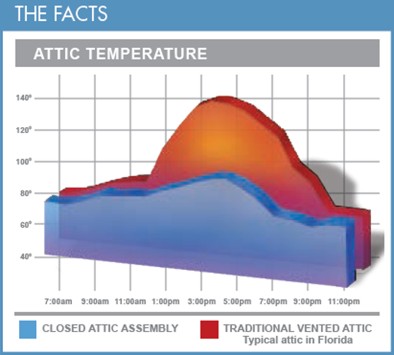THE DEBATE: To Vent or Not to Vent?
A vented attic is, without a doubt, the most hostile environment in a building. It can reach temperatures of over 150° in the summer and be well below freezing in the winter. Any system that must operate in such an environment must work very hard just to overcome the temperature extremes. A vented attic also allows hot moisture laden air to accumulate in the attic space and often times create a condition where the vapor condenses inside the attic. This moisture along with air and all sorts of cellulose materials are the three basic items needed for the growth of mold. Venting can also allow blowing rain and snow to enter the attic and accumulate on the attic floor or ceiling, possibly causing damage to the sheet-rock Another danger of vented attics is burning embers entering and causing major structural damage.
 Converting attics into a semi-conditioned space in hot climates by closing soffits, gable and ridge vents is a positive design approach in reducing the moisture loads in houses and buildings. By applying Spray Polyurethane Foam to the roofline and making the attic area part of the conditioned space*, you can overcome these problems and will enhance the operation of various systems located in the attic. Moving the duct system from an unconditioned area into the conditioned space has a drastic effect on its performance since its insulation is typically an R-4 to an R-6.
Converting attics into a semi-conditioned space in hot climates by closing soffits, gable and ridge vents is a positive design approach in reducing the moisture loads in houses and buildings. By applying Spray Polyurethane Foam to the roofline and making the attic area part of the conditioned space*, you can overcome these problems and will enhance the operation of various systems located in the attic. Moving the duct system from an unconditioned area into the conditioned space has a drastic effect on its performance since its insulation is typically an R-4 to an R-6.
Any leakage on the supply side of the system is kept inside the conditioned space and isn’t lost to the exterior world. In a vented attic, any air leakage will allow hot humid air, along with dust and allergens, to be sucked into the ducts and circulated throughout the house.
*New construction homes/buildings can achieve on average a 7-10° difference in temperature from the conditioned living space to the attic by means of SPF’s complete thermal package (insulating all exterior walls and roofline of the conditioned space). For example, a living area of 75° with a complete thermal package would have an average attic temperature of 82-85°. New/existing homes/buildings that only insulate the attic with SPF can reduce the attic temperature by an average of 30-45°.
Benefits of an Unvented Attic:
- It reduces sensible and latent heat loads.
- It eliminates air infiltration: preventing 90% of moisture intrusion, 40% of energy loss and mold growth.
- It reduces damage from wind-driven rain.
- It eliminates condensation on ducts.
- It cuts utility bill substantially.

